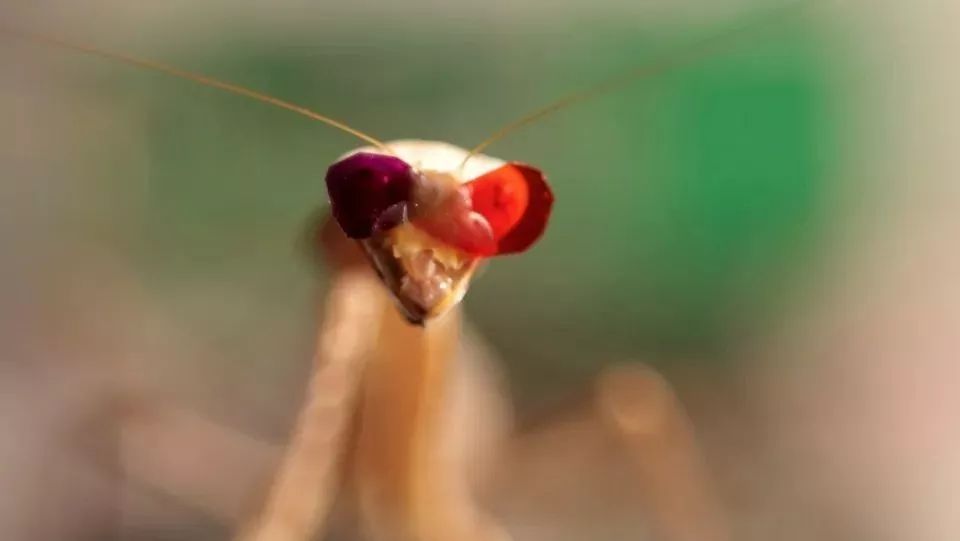
No matter how many times I see this picture, I feel fascinated and cute.
trim two small pieces of filters of different colors, add a small drop of beeswax in the middle of the praying mantis's eyes, and then carefully fix the filter in front of its eyes. In this way, we got a mantis with 3D glasses:
Yes, in the laboratories of Vivek Nityananda and other researchers, praying mantis all have their own 3D glasses (red and blue glasses similar to human glasses), and the researchers have tailored all kinds of "3D movies" for them, all in order to study the stereoscopic vision of this insect.
We humans use binocular parallax as a clue to spatial distance: the picture seen by two eyes is slightly biased, and the distance of the same object can be sensed by the degree of deviation of the same object in the two-eye picture. Many animals we are familiar with perceive space in this way, but among insects, there is little evidence of binocular stereo vision. The researchers proved with specially made mini 3D glasses that the mantis does have stereo vision based on binocular parallax: if a 2D video pattern is played, the object appears far away, and the mantis does not respond to it. When playing a designed 3D film, the mantis wearing 3D glasses will feel as if the object is very close to them, and they will react to it.
and just recently, this group of researchers made a new discovery in the praying mantis wearing 3D glasses. This time, they use more complex "3D movies" that contain dots that move in different directions with different lights and shades. As a result, the researchers found that the mantis's brain processes stereo vision with an "algorithm" that is quite different from that of humans.
(the researcher and his mantis subjects)
if the visual center wants to use binocular parallax to calculate the distance and proximity of an object, the first step is to match the same object seen by both eyes. In humans, such a match depends on the light and dark clues of the picture. If the light and dark clues do not match (for example, the two eyes see the opposite picture), the picture will not match, nor can it produce a corresponding three-dimensional sense.
however, this light-shading mismatch does not disturb the mantis. For Mantis, the key to matching the two images is movement. They will match where they move, so as to "calculate" the spatial distance of the moving part. Even if the light and shade on both sides are opposite, or even if the local dots move in different directions, they can still match.
Are you currently busy looking for simple white wedding dresses to bring out your femininity? Browse through our excellent fabric collections now!
the researchers speculate that this inaccurate "algorithm" of picture matching may be more suitable for the brains of insects. Compared with humans, mantis has far fewer neurons that make up the central nervous system. Their binocular stereo vision perception systems do not match carefully in many ways like humans, but focus on observing where there is a moving target and estimating how far the moving target is from them, ignoring other details. This slightly rough "algorithm" is more efficient for insects and is good enough for predation.
this interesting discovery also makes people wonder whether other insects have similar stereo vision mechanisms. However, I'm afraid we have to find the right 3D glasses for them and fix them in front of the screen.
Source: https://www.theatlantic.com/science/archive/2018/02/praying-mantises-3d-glasses/552791/
http://www.cell.com/current-biology/pdf/S0960-9822(18)30014-9.pdf